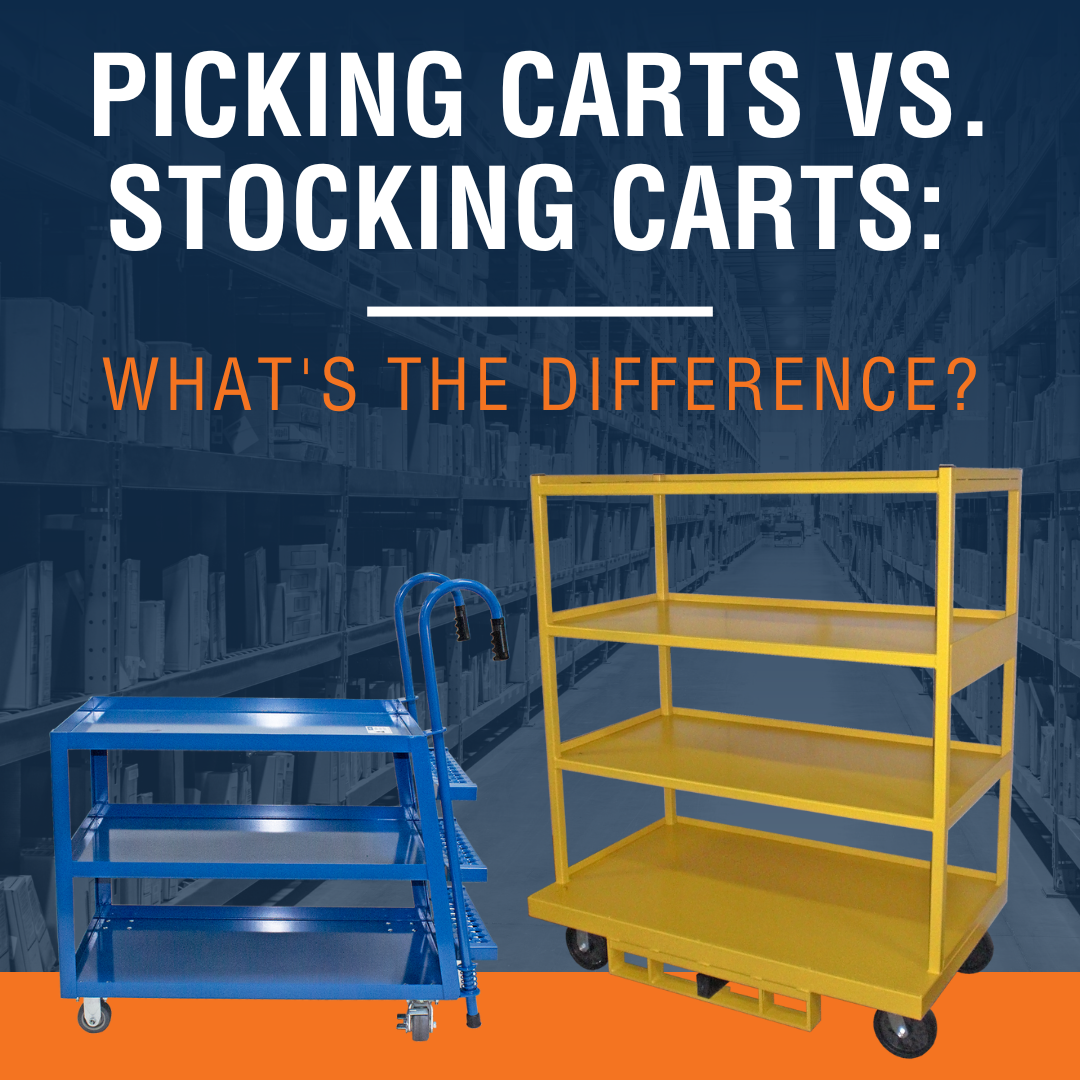We use cookies to make your experience better. To comply with the new e-Privacy directive, we need to ask for your consent to set the cookies. Learn more.
Picking Carts Vs. Stocking Carts: What's the Difference?
The key piece of material handling equipment that runs the global supply chain isn’t a forklift, an automated guided vehicle, or even the mighty pallet itself. It’s the cart. Automation is spreading slowly, and most distribution centers, warehouses, and retail outlets can’t function without a workforce of order pickers and a fleet of sturdy, reliable carts.

But when you’re outfitting your facility for smooth material flow, cart terminology can get in the way. Do you choose picking carts? Stocking cart? Stock picking carts? It’s simple, you might think: Picking carts are for order picking, and stocking carts are for placing items on retail shelves.
But certainly you could use a “stocking cart” to pick orders, and you could use a “picking cart” to restock shelves. The carts available on today’s crowded market often share similar design features, no matter what manufacturers choose to call them. That’s where confusion sets in.
In this post, we’ll attempt to place clear boundaries between picking carts and stocking carts — and identify the features that best align with the day-to-day tasks at your facility, whether you operate a busy e-commerce DC, a long-term storage warehouse, a brick-and-mortar retail outlet, or even a manufacturing plant.
Explore the BHS collection of picking, stocking, and material handling carts here.
5 Features That Distinguish Picking Carts from Stocking Carts
From a distance, and there’s not a lot of difference between a cart designated “picking” or “stocking.” They’re both rows of shelves packed into a rectangular frame, with four casters for mobility. Look a little closer, however, and you’ll see the differences that support both sides of the physical sales process, whether customers buy online or in person. Pay attention to these five features:
- Load Capacity - E-commerce fulfillment centers often use batch or wave picking strategies, creating extremely long pick lists for each trip down the aisles. You need a cart that can keep up. Putaway is usually a lighter-duty load. Carts with weight capacities measured in the low-to-mid hundreds are usually stocking carts. Limits that surpass 1,000 pounds are probably picking carts.
- Usable Square Footage - It also takes a lot more storage space to pick dozens of orders than it does to restock a single shelf (not always, of course, but often enough to affect cart design.) Picking carts frequently have larger shelves, more shelves, or both, compared to stocking carts.
- Push Bars or Handles - To be clear, both picking carts and stocking carts may include push bars or handles. But they seem to appear more often on stocking carts, since picking carts are usually tall enough for the frame to support ergonomic operation. In fact, on stocking carts, handles are often incorporated into the next feature on our list.
- Integrated Step Ladders - Not every stocking cart includes a built-in ladder. But in our research, carts with integrated ladders are usually associated with stocking, not picking. Ladders are a good indicator of a stocking cart as opposed to a picking cart.
- Forklift Compatibility - Stocking shelves is a unit-by-unit operation, often associated with public-facing retail. You won’t usually see a forklift in the aisle of your local grocery store (though you may see pallet jacks). In a warehouse or distribution center, on the other hand, order pickers work side-by-side with forklift operators. It’s helpful for every piece of material handling equipment to include forklift pockets in these use cases — including order picking carts. So this rare feature, when it appears, is found on picking carts, not stocking carts.
So should you build a fleet of picking carts, stocking carts, or both? That depends on the work you need to accomplish.
Common Use Cases for Picking Carts Vs. Stocking Carts
While we’ve tried to distinguish picking carts from stocking carts, the truth is, they perform a lot of the same tasks. They both reduce workload on humans, creating valuable ergonomic gains. They both ramp up throughput and productivity. Still, small differences make each class of equipment ideally suited to specific, sometimes overlapping, tasks:
Best Uses for Picking Carts
As the name implies, picking carts are built for order picking. But they’re also helpful in the following applications:
- Line feeding at manufacturing plants
- Safely handling heavy components, from dies to tools to engine parts
- Higher-capacity stock storage
- Handling via forklift (if fitted with fork pockets)
- Unit putaway at warehouses, DCs, and retail outlets
- General material handling
Best Uses for Stocking Carts
Stocking carts are designed to simplify the act of placing products on shelves, usually associated with brick-and-mortar retail. Here are a few alternate use cases for these tools, too:
- Combined tool storage and access to overhead spaces (with integrated ladders)
- Lighter-duty order picking
- Unit-level warehouse putaway
- Utility transportation for construction and industrial operations
- Material handling in narrow aisles
Regardless of your facility’s unique material handling needs, BHS has the solution. Contact our sales team at 1.800.BHS.9500 for more help choosing the best equipment for any use case.
